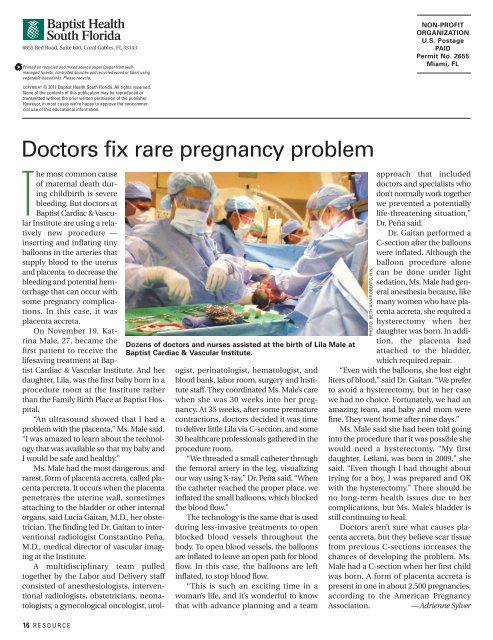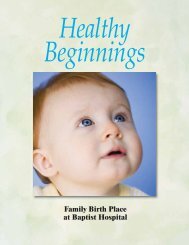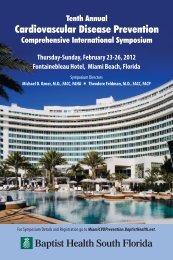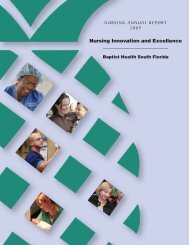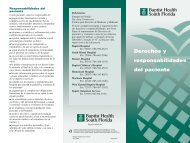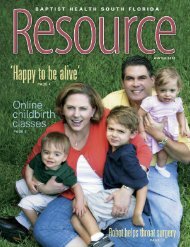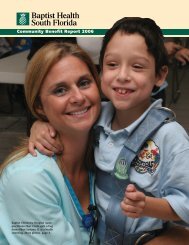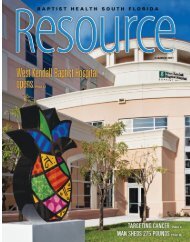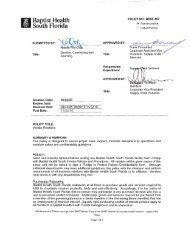SPRING 2011 - Baptist Health South Florida
SPRING 2011 - Baptist Health South Florida
SPRING 2011 - Baptist Health South Florida
Create successful ePaper yourself
Turn your PDF publications into a flip-book with our unique Google optimized e-Paper software.
6855 Red Road, Suite 600, Coral Gables, FL 33143<br />
Printed on recycled and mixed source paper (paper from wellmanaged<br />
forests, controlled sources and recycled wood or fiber) using<br />
vegetable-based inks. Please recycle.<br />
COPYRIGHT © <strong>2011</strong> <strong>Baptist</strong> <strong>Health</strong> <strong>South</strong> <strong>Florida</strong>. All rights reserved.<br />
None of the contents of this publication may be reproduced or<br />
transmitted without the prior written permission of the publisher.<br />
However, in most cases we’re happy to approve the noncommercial<br />
use of this educational information.<br />
NON-PROFIT<br />
ORGANIZATION<br />
U.S. Postage<br />
PAID<br />
Permit No. 2655<br />
Miami, FL<br />
Doctors fix rare pregnancy problem<br />
Dozens of doctors and nurses assisted at the birth of Lila Male at<br />
<strong>Baptist</strong> Cardiac & Vascular Institute.<br />
The most common cause<br />
of maternal death during<br />
childbirth is severe<br />
bleeding. But doctors at<br />
<strong>Baptist</strong> Cardiac & Vascular<br />
Institute are using a relatively<br />
new procedure —<br />
inserting and inflating tiny<br />
balloons in the arteries that<br />
supply blood to the uterus<br />
and placenta to decrease the<br />
bleeding and potential hemorrhage<br />
that can occur with<br />
some pregnancy complications.<br />
In this case, it was<br />
placenta accreta.<br />
On November 19, Katrina<br />
Male, 27, became the<br />
first patient to receive the<br />
lifesaving treatment at <strong>Baptist</strong><br />
Cardiac & Vascular Institute. And her<br />
daughter, Lila, was the first baby born in a<br />
procedure room at the Institute rather<br />
than the Family Birth Place at <strong>Baptist</strong> Hospital.<br />
“An ultrasound showed that I had a<br />
problem with the placenta,” Ms. Male said.<br />
“I was amazed to learn about the technology<br />
that was available so that my baby and<br />
I would be safe and healthy.”<br />
Ms. Male had the most dangerous, and<br />
rarest, form of placenta accreta, called placenta<br />
percreta. It occurs when the placenta<br />
penetrates the uterine wall, sometimes<br />
attaching to the bladder or other internal<br />
organs, said Lucia Gaitan, M.D., her obstetrician.<br />
The finding led Dr. Gaitan to interventional<br />
radiologist Constantino Peña,<br />
M.D., medical director of vascular imaging<br />
at the Institute.<br />
A multidisciplinary team pulled<br />
together by the Labor and Delivery staff<br />
consisted of anesthesiologists, interventional<br />
radiologists, obstetricians, neonatologists,<br />
a gynecological oncologist, urologist,<br />
perinatologist, hematologist, and<br />
blood bank, labor room, surgery and Institute<br />
staff. They coordinated Ms. Male’s care<br />
when she was 30 weeks into her pregnancy.<br />
At 35 weeks, after some premature<br />
contractions, doctors decided it was time<br />
to deliver little Lila via C-section, and some<br />
30 healthcare professionals gathered in the<br />
procedure room.<br />
“We threaded a small catheter through<br />
the femoral artery in the leg, visualizing<br />
our way using X-ray,” Dr. Peña said. “When<br />
the catheter reached the proper place, we<br />
inflated the small balloons, which blocked<br />
the blood flow.”<br />
The technology is the same that is used<br />
during less-invasive treatments to open<br />
blocked blood vessels throughout the<br />
body. To open blood vessels, the balloons<br />
are inflated to leave an open path for blood<br />
flow. In this case, the balloons are left<br />
inflated, to stop blood flow.<br />
“This is such an exciting time in a<br />
woman’s life, and it’s wonderful to know<br />
that with advance planning and a team<br />
PHOTO: BETH ANN ROBERTS, R.N.<br />
approach that included<br />
doctors and specialists who<br />
don’t normally work together<br />
we prevented a potentially<br />
life-threatening situation,”<br />
Dr. Peña said.<br />
Dr. Gaitan performed a<br />
C-section after the balloons<br />
were inflated. Although the<br />
balloon procedure alone<br />
can be done under light<br />
sedation, Ms. Male had general<br />
anesthesia because, like<br />
many women who have placenta<br />
accreta, she required a<br />
hysterectomy when her<br />
daughter was born. In addition,<br />
the placenta had<br />
attached to the bladder,<br />
which required repair.<br />
“Even with the balloons, she lost eight<br />
liters of blood,” said Dr. Gaitan. “We prefer<br />
to avoid a hysterectomy, but in her case<br />
we had no choice. Fortunately, we had an<br />
amazing team, and baby and mom were<br />
fine. They went home after nine days.”<br />
Ms. Male said she had been told going<br />
into the procedure that it was possible she<br />
would need a hysterectomy. “My first<br />
daughter, Leilani, was born in 2009,” she<br />
said. “Even though I had thought about<br />
trying for a boy, I was prepared and OK<br />
with the hysterectomy.” There should be<br />
no long-term health issues due to her<br />
complications, but Ms. Male’s bladder is<br />
still continuing to heal.<br />
Doctors aren’t sure what causes placenta<br />
accreta, but they believe scar tissue<br />
from previous C-sections increases the<br />
chances of developing the problem. Ms.<br />
Male had a C-section when her first child<br />
was born. A form of placenta accreta is<br />
present in one in about 2,500 pregnancies,<br />
according to the American Pregnancy<br />
Association.<br />
— Adrienne Sylver<br />
16 RESOURCE


